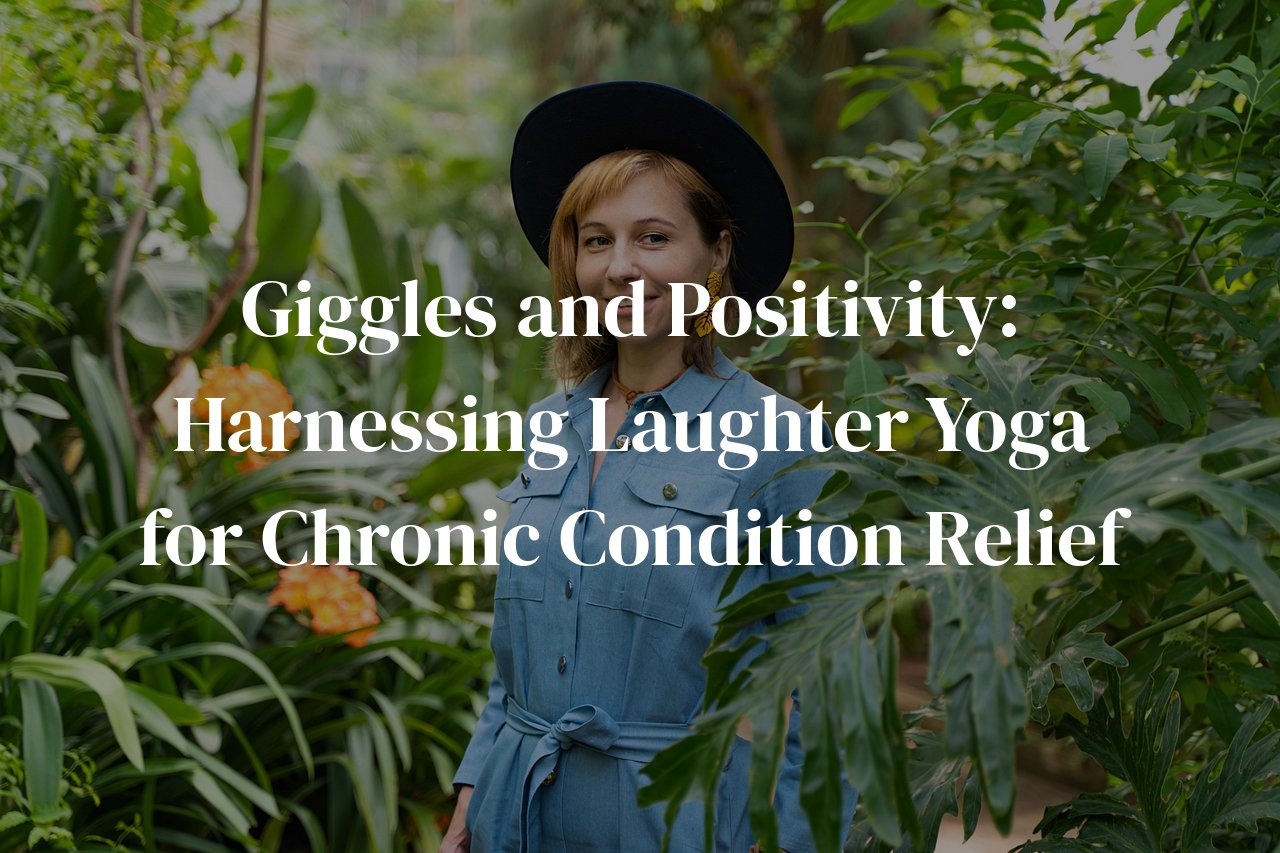
In this journey of healing and health management, one often overlooks a remedy that’s nestled within us all—laughter. As I fold my experiences with the light-hearted practice of laughter yoga into the words of this post, we shall explore how this unconventional approach breathes hope into the routines of those battling chronic illnesses. This blog post aims to shed light on the science behind laughter yoga and its role in ameliorating the daily lives of those living with long-term health conditions.
By delving into the personal anecdotes of resilience and recovery, readers will uncover insights that transcend traditional medical advice, offering a fresh perspective on how integrating laughter yoga into chronic illness management can catalyze a monumental shift towards physical and emotional well-being.
Table of Contents
Understanding Laughter Yoga: A Beacon in Chronic Illness
Laughter Yoga, an innovative brainchild blending the deep, rhythmic breathing of traditional yoga with the infectious, natural act of laughing, has emerged as a beacon of hope for those battling chronic conditions. I recall vividly my own journey towards understanding this harmonious practice. The concept, simple yet profound, was founded by Dr. Madan Kataria in 1995, who saw laughter as a universal language with the power to heal and unite.
The essence of Laughter Yoga lies in its ability to stimulate a holistic rejuvenation. During sessions, members engage in eye contact and childlike playfulness, which encourages genuine laughter. The ‘fake it till you make it’ approach triggers a cascade of authentic giggles and chortles. This unique form of exercise does not rely on humor or jokes, which makes it universally accessible, transcending cultural and linguistic barriers.
Laughter Yoga’s magic extends beyond the mere physical act of laughing. It’s a psychophysiological phenomenon where the act of laughing itself activates the release of endorphins, the body’s natural painkillers, providing a kind of analgesic without side effects. Furthermore, it enhances oxygen intake, stimulates the heart and lungs, and improves circulation, thereby supporting the body’s resilience against stress and bolstering the immune system which is often compromised in those with chronic illness.
In my early encounters with Laughter Yoga, I was skeptical. How could something as simple as laughter have such significant implications for health? Yet, as I stood amidst a circle of laughter yogis, their chuckles harmonizing with my own tentative giggles, I experienced an epiphany. The heaviness of chronic pain seemed to lift, if only for the duration of the session, and the mental fog dispersed, replaced by a clarity and lightness I hadn’t felt in years.
Laughter Yoga aligns well with the concept of integrative medicine, which looks at the patient holistically. It is not presented as a standalone cure for chronic conditions but as a complementary approach that can amplify the effects of conventional treatment plans. The focus is on improving quality of life, with an emphasis on emotional and social support systems. Laughter Yoga fortifies these aspects, building a community for support and fostering an environment where joy can flourish amidst the trials of chronic illness.
It is a reminder that sometimes, hope and relief can come from unexpected quarters, and Laughter Yoga is certainly a testament to that. The practice is not about dismissing the realities of chronic illness but about adding a tool to our arsenal that makes the battle a little lighter, a little more infused with joy.
My First Chuckle: Personal Discovery of Laughter Yoga’s Impact
Embarking on my wellness journey, I stumbled upon what seemed like an oasis in the arid desert of chronic condition management: laughter yoga. Initially skeptical of this seemingly simplistic approach, I decided to give it a shot — my curiosity piqued by countless anecdotal tales of its subtle yet profound influence on well-being. There I was, in a modestly furnished community center room, face to face with my inaugural laughter yoga session.
To my amazement, the transformation was both immediate and palpable. The rhythmic clapping and chanting of ‘Ho, ho, ha-ha-ha’ felt awkwardly amusing at first, but as we locked eyes and genuinely shared the act of laughing, artificiality turned into a contagious, authentic gale of giggles. This was no ordinary guffaw; it was a physical sensation that cascaded throughout my entire body, leaving a warm afterglow that seemed to mute my usual aches and anxieties.
The exercises, ranging from ‘Lion Laughter’ where we roared our stress away, to ‘Milkshake Laughter’ that had us blending imaginary drinks with chuckles, had a peculiar way of transcending the actual acts. They blended mirth with movement, casting a spotlight on the present moment that was freeing and immersive. By the end of the session, my initial amusement had blossomed into an appreciation for the shared human experience, resonating deep within me.
In the days that followed, I noticed subtle shifts. The proverbial clouds of chronic discomfort seemed less daunting; my resilience quietly fortified by the memory of uninhibited laughter. Even on days when smiling seemed an uphill battle, just the memory of that experience could coax a grin out of hiding, offering a subtle reprieve from persistent pain.
This personal revelation was more than just an enjoyable hour; it was proof of concept for the transformative power of laughter yoga in the realm of chronic illness management. It showcased the potential for joy to be both a journey and a destination, an accessible tool that could be wielded to combat the often invisible battles waged within the realm of chronic conditions.
Scientific Smiles: The Evidence Supporting Laughter and Health
Embarking on a quest to validate the joyous claims of laughter yoga, I plunged into the scientific terrain where giggles fight gravely with graphs. With a sleuth’s eye, I scoured research that paints smiles not just as curves but as remedies. And, oh, the discoveries were as heartwarming as the laughter itself!
My exploration unearthed the delightful truth about endorphins – our body’s natural painkillers. Whenever laughter yoga prompted my chuckles, it wasn’t just an emotional release; it stirred up an endorphin cocktail, offering relief akin to a pharmacist’s concoction but with a dash of joy. Studies have consistently shown that engaging in laughter can significantly reduce pain perception, particularly beneficial for those bearing the brunt of chronic conditions.
What’s more, with every hearty laugh, a cascade of immunoglobulins fortifies the immune system’s ramparts, girding against sickness. My deep dives revealed that laughter yoga participants often report fewer episodes of colds and infections. This immune-boosting capability forms a formidable defense, especially for those with weakened systems.
Yet another fascinating find was the empathy laughter cultivates. The shared experience of laughter yoga builds a community, a fellowship of resilience braving illness together. It introduces social bonds that are crucial for psychological well-being, which, in turn, can translate into improved physical health outcomes for individuals with chronic illnesses. Laughter in company is a balm unlike any solitary medicine, one that wraps its arms around you in an invincible embrace.
Lastly, the ventilatory effect of a rollicking laugh intrigued me the most. As a pseudo-aerobic workout, laughter yoga promotes better oxygenation, which enhances overall functioning and provides a sense of revitalization that many with chronic ailments yearn for. This unexpected respiratory benefit subtly nudges physiology towards a more harmonious state, proving that every chuckle holds a breath of life.
These scientific vignettes only scratch the surface of how laughter can be both a symphony and a strategy in our health repertoire. And through personal trial, I found each of these points not just theoretically sound but practically profound in navigating the often murky waters of chronic illness. Let the scientific smiles guide us to believe that within every burst of laughter, there’s a whisper of hope for better health.
The Daily Dose: Integrating Laughter Yoga into Chronic Care Routines
Bringing the spirit of laughter into the management of chronic conditions requires not just a one-off session but embedding it into daily life as a healing routine. With the sunrise, I invite chuckles to join me in my morning ritual. It’s as essential as my medication, but far more delightful. In the quiet of dawn, I begin with deep breathing exercises that transition into gentle laughs. What starts as forced, mechanical mirth soon bubbles into genuine joy. It’s a transformation that never ceases to amaze me.
As part of my diet of joy, lunchtime isn’t just for nourishing the body but also the soul. I’ll share jokes with friends or even indulge in playful laughter while preparing my meal—a giggle garnish, if you will. The act of chuckling while chopping carrots or laughing as lentils simmer on the stove turns an ordinary task into a therapeutic moment, making the kitchen a crucible of cheer.
Equally important, integrating moments of laughter into my workday breaks down the monotony and stress. Be it a chuckle break instead of a coffee break or starting a meeting with a witty observation, it’s these snippets of silliness that punctuate the day with positivity, opening a valve to release the pressures that come with chronic ailment and work-related demands.
Evening walks are no longer solitary strolls but opportunities to engage with the world through the lens of laughter. I’ll sometimes count my steps in laughs or greet fellow walkers with a light-hearted quip. The open sky seems to laugh along, and the wind carries my carefree cackles across the landscape. It’s in these moments that I’m reminded of the sheer power of laughter to transform even a simple walk into a joyful expedition.
And finally, as night falls and calm envelops the world, I reflect on the day’s joyous episodes with a gratitude journal. Writing down three instances of laughter not only cements them in memory but often brings forth a fresh wave of giggles. It’s like giving myself permission to relish in the lighter side of life and to allow the healing power of laughter to work its magic—a lullaby of laughter ushering in restful sleep.
Echoes of Joy: Real-Life Stories of Transformation and Healing
The concept of laughter yoga was always intriguing, but it wasn’t until I witnessed its real impact that I became a true believer. One of the most remarkable transformations I’ve seen was through the eyes of Sarah, a middle-aged woman with rheumatoid arthritis. Sarah’s journey began at a local community center where laughter yoga sessions were held weekly. With gentle ‘ho-ho, ha-ha’ chants, she found herself buoyed by a sea of giggles. Over time, her stiffness seemed to fade with each session, her movements grew less painful, and her smiles more genuine. Laughter yoga didn’t cure the arthritis, but it rekindled the joy that pain had buried.
Another potent story is that of David, who was battling depression alongside diabetes. The mental weight of his chronic condition was a heavy burden until laughter yoga entered his life. I saw him transform from a man who barely spoke or made eye contact into someone who led group activities with fervor. The phenomenal shift wasn’t just in his spirit; his blood sugar levels became easier to manage – a testament to the mysterious yet powerful link between laughter, stress reduction, and improved metabolic control.
Lastly, there’s the tale of Emily, living with chronic fatigue syndrome. A perpetual fog seemed to cloud her days until she embraced the practice of laughter yoga. The paradox of exerting energy to gain more of it seemed insurmountable at first, but Emily’s persistence paid off. The laughter sessions became a wellspring of energy, lifting both her mood and her vitality. Her anecdote stands as a beacon, shining on the potential of laughter to morph a weariness-ridden life into an existence brimming with newfound vibrancy.
These stories, each unique, weave together a tapestry of evidence that laughter yoga is more than just an exercise; it’s a form of mental, emotional, and sometimes even physical therapy. They serve as heartwarming reminders that sometimes, healing can be found not only in hospitals and clinics but in the laughter-filled rooms where the heart finds its ease and the body learns to heal itself.
Conclusion
As we draw the curtains on our exploration of laughter yoga’s therapeutic potential, we embrace the notion that wellness truly resonates beyond conventional treatment realms. Whether you or your loved ones are navigating the turbulent waters of chronic illness, incorporating the power of laughter into your care strategy can ignite a sense of joy and fortify your coping mechanisms. Let your laughter be as much a part of your healing as your medication, and watch as life’s vibrant colors paint over the greys of routine healthcare.



